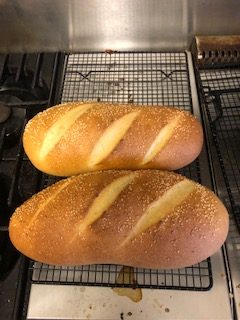Forum Replies Created
-
AuthorPosts
-
I don't know what happened to the first post, I do remember seeing it.
A post of yours was flagged as spam a few days back, I don't know why. I don't see anything in the spam queue at the moment, though, so that doesn't appear to explain why this one vanished.
I thought my timetable for Christmas dinner was complicated, but after reading that article, I need a nap.
Jeffrey Hamelman suggests making breadsticks with the semolina dough I made the other day, I may have to try that some time.
I heard back from Jeffrey Hamelman, the error in the sugar in the semolina bread recipe was fixed in the 2nd edition of his book.
Fixing errors in print is an author's nightmare. I remember when my wife got her copies of the book she co-authored, she found a grammatical error on the first page.
With cookbooks there are just too many little things that can get messed up.
I've never had pancakes with pieces of gingerbread cookies in them, sounds like something you'd get at a Disney restaurant.
Aaron, have you ordered anything from NY Bakers? I'm looking at getting a selection of rye flours from them to start my rye experiments. 3 pounds each of several types of rye flours should get me through the first few months, then I may start ordering in bulk, since my local options are pretty much nil.
I have a buttermilk rye recipe that I developed posted here, it makes a very good bread for reubens. The last several times I made rye bread, though, I made Peter Reinhart's marbled rye bread in BBA, it is as close to a foolproof rye recipe as you'll find. I increase the proportion of rye to wheat flour from 30/70 to 40/60 and I use a coarse pumpernickel flour that I got from a Mennonite store in TN a year ago, I haven't found a direct local or online replacement for it so I'm not sure what I'll do when I run out.
I may try to contact the store in TN and see if they'll tell me who they bulk order from or if they'll ship it. (I'm also thinking about the possibility of driving to Asheville NC for the 2020 Asheville Bread Festival in May, which would take me right past the Mennonite store.)
When you get the percentage of rye flour to 50% or higher, you are more likely to have to deal with rye flour's tendency to produce a gummy dough.
I'm going to be trying some of Stanley Ginsberg's rye recipes after the holidays, but I may have to order the rye flours he calls for, the ONLY rye flour I can find locally these days is Bob's Red Mill organic dark rye, and I want some other options. I stopped at the locally owned 'gourmet' grocery store in Lincoln earlier today, they didn't even have that. I will check Whole Foods next time I'm in that part of town, but I don't seem to recall a lot of interesting flour choices there. The local co-op seems to have fewer flours than they used to, too.
In addition to the baking temp/time issue, there is one difference between the bulk quantities and the home quantities worth noting. It is 2% sugar in baker's math form, and the home quantity recipe correctly says .6 ounces, which would be about 4 1/2 teaspoons, but then it restates that as 1/2 teaspoon. This may just be a typo (missing the 4).
If you've got the 2nd edition of his book, see if these were revised. There is an errata sheet available for the first edition, it does not include the sugar discrepancy for this recipe. I also sent Jeffrey Hamelman a note on this.
I did coat it with sesame seeds, as suggested.
The semolina bread was good with tuna salad, my wife toasted hers, and had some with jam and some with peanut butter, she said they were pretty good, too. (It smells good toasted.)
I think this bread will be added to the repertoire.
It is a bit chewier than I might have expected, I don't know whether that's because of the semolina or because it used a pre-ferment. It has an excellent mouth feel, though.
I'm thinking I may make tuna salad to go on my fresh semolina bread.
They baked a lot faster than I was expecting them to (20 minutes at 450, with steam), the recipe said 35-40 minutes), but they sure look done on the outside and the internal temp was 206, so I took them out.
Now I have to wait for them to cool!
I'm hoping they'll be like the ones we used to get at McGinnis Sisters in Pittsburgh, which closed all its stores.
Followup: They're pretty good!
Attachments:
You must be logged in to view attached files.I'm making the semolina bread out of the first edition of Jeffrey Hamelman's book (the pre-ferment variant) today.
Is there a UPS store within reasonable range? I find their prices to be better than either the USPS or Fedex.
We had ground beef stroganoff over toast
We had spaghetti with cheese toast.
I already use fairly heavy aluminum baking sheets (3/4 size, 16x22 and nearly two pounds each), I might try double-sheeting them or dropping the temperature a little.
We like them well enough that I'm sure I'll make them again, my guess is it'll be easier the second time around. I might make a little more of the filling next time around, but not a lot more.
Some of them got a little too done on the bottom, but they're just barely done in the middle, not sure whether to adjust the baking time, the temperature or both. (I baked them for 13 minutes at 425.)
Lightly oiling the parchment might also help.
-
AuthorPosts
